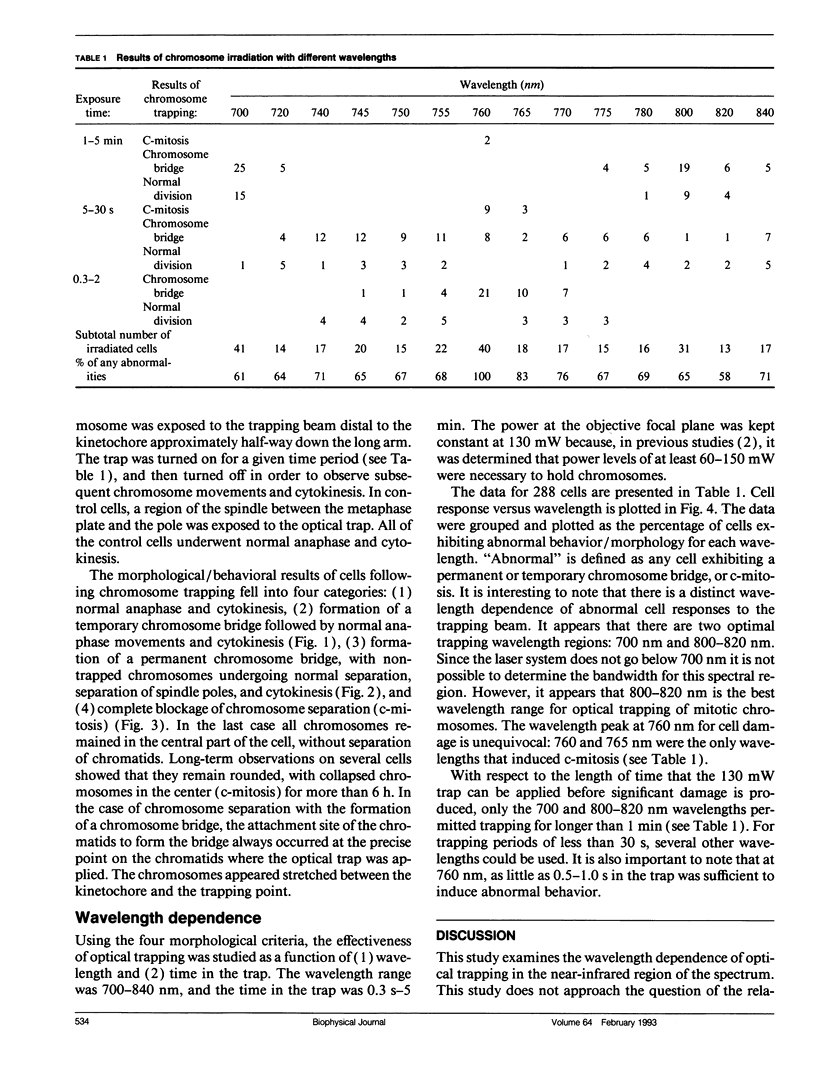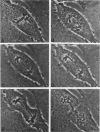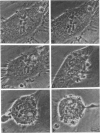Abstract
Using a tunable titanium-sapphire laser, we have compared different wavelengths (from 700 to 840 nm) for their utility in optical trapping of chromosomes in mitotic rat kangaroo Potorous tridactylus (PtK2) cells. It was found that irradiation with a near-infrared light induces the sticking together of chromosome shoulders. The attached chromatids failed to separate, or separated with significant delay and formed a chromosome bridge during anaphase. Using this bridge (and induced c-mitosis) as a reference, we compared the action of different wavelengths (from 700 to 840 nm). Chromosomes were irradiated at metaphase and the cells were observed until the end of cytokinesis. Chromosomes were irradiated for different periods of time, using 130 mW of power at the objective focal plane. The biological responses observed after optical trapping were: (1) normal cell division, (2) formation of a temporary chromosome bridge, (3) formation of a permanent chromosome bridge, (4) complete blockage of chromosome separation (c-mitosis). The chromosomes were found to have a maximal sensitivity to 760-765 nm light and minimal sensitivity to 700 and 800-820 nm light. Cells with chromosomes irradiated for a long time, using wavelength 760-765 nm, generally were incapable of going through anaphase and remained in c-mitosis. We conclude that the optimal wavelengths for optical trapping are 700 and 800-820 nm.
Full text
PDF





Images in this article
Selected References
These references are in PubMed. This may not be the complete list of references from this article.
- Ashkin A., Dziedzic J. M., Yamane T. Optical trapping and manipulation of single cells using infrared laser beams. Nature. 1987 Dec 24;330(6150):769–771. doi: 10.1038/330769a0. [DOI] [PubMed] [Google Scholar]
- Berns M. W., Aist J. R., Wright W. H., Liang H. Optical trapping in animal and fungal cells using a tunable, near-infrared titanium-sapphire laser. Exp Cell Res. 1992 Feb;198(2):375–378. doi: 10.1016/0014-4827(92)90395-o. [DOI] [PubMed] [Google Scholar]
- Berns M. W., Wright W. H., Tromberg B. J., Profeta G. A., Andrews J. J., Walter R. J. Use of a laser-induced optical force trap to study chromosome movement on the mitotic spindle. Proc Natl Acad Sci U S A. 1989 Jun;86(12):4539–4543. doi: 10.1073/pnas.86.12.4539. [DOI] [PMC free article] [PubMed] [Google Scholar]
- Berns M. W., Wright W. H., Wiegand Steubing R. Laser microbeam as a tool in cell biology. Int Rev Cytol. 1991;129:1–44. doi: 10.1016/s0074-7696(08)60507-0. [DOI] [PubMed] [Google Scholar]
- Liang H., Wright W. H., He W., Berns M. W. Micromanipulation of mitotic chromosomes in PTK2 cells using laser-induced optical forces ("optical tweezers"). Exp Cell Res. 1991 Nov;197(1):21–35. doi: 10.1016/0014-4827(91)90475-a. [DOI] [PubMed] [Google Scholar]
- McNeill P. A., Berns M. W. Chromosome behavior after laser microirradiation of a single kinetochore in mitotic PtK2 cells. J Cell Biol. 1981 Mar;88(3):543–553. doi: 10.1083/jcb.88.3.543. [DOI] [PMC free article] [PubMed] [Google Scholar]





